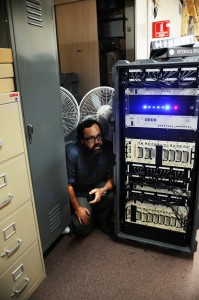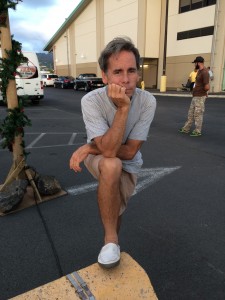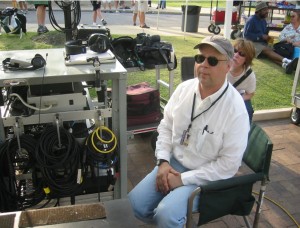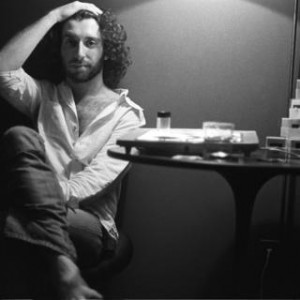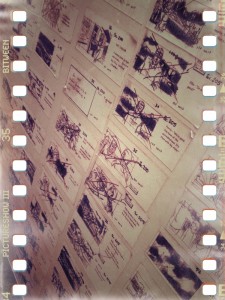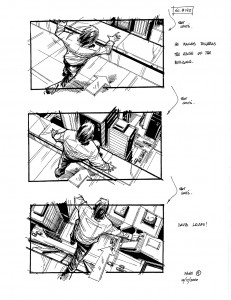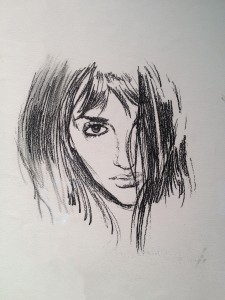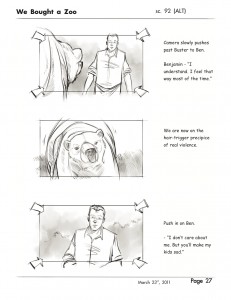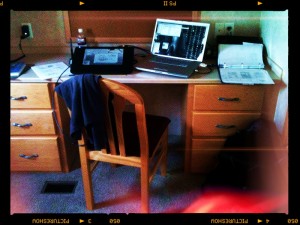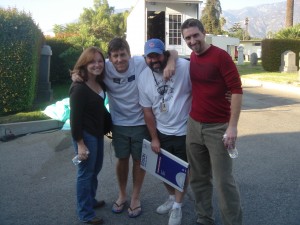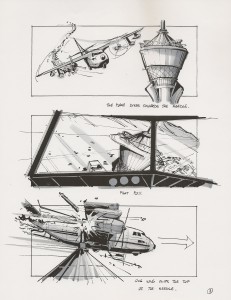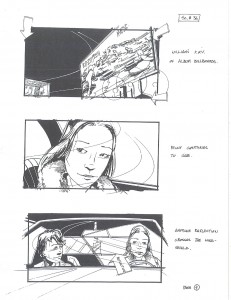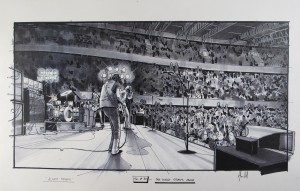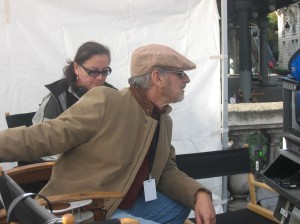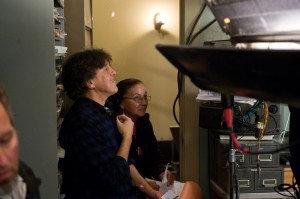
Cameron and Ana Maria on the set of Zoo
We are pleased to introduce you to Ana Maria Quintana, Script Supervisor on Cameron’s last four films (Almost Famous, Vanilla Sky, Elizabethtown and We Bought A Zoo). She was born and raised in Chile before moving to New York when she was fourteen years old. The family eventually headed west and Ana Maria studied film at L.A. City College. She has worked on more than 50 movies in a career that now spans more than four decades. We chat with Ana Maria in two parts about her duties as Script Supervisor, some of the many directors and films she has worked on and much more.
Tell us what a Script Supervisorʼs main duties are.
First of all and most importantly: to have total knowledge of the script. You are responsible for breaking it down in every department. Props, wardrobe, make-up, hair, set dressing, time of day, time of the year.
We time a script so that we know how long the script is and how long each scene is. This will be helpful throughout the shooting. We keep a tally to compare so that the Director and the Editor can use this to make sure that they are not running too long. If a film is meant to be 2 hours you don’t want to shoot a 4-hour film.
Once we start production, we are involved in all the rehearsals, set-ups and shooting of the film. We keep detailed notes on the shooting day, scene numbers, take numbers, camera information, lenses and filters. We describe each scene and make notes on each take.
All of our notes are given to the Editor to use for his or her assembly, and the Director will later refer to them during his or her cut. The notes will tell them the good takes from the bad, the incomplete from the complete, what each take had that was particularly good or bad, and any other notes that might help distinguish the shooting scene during the editing process.
During filming, we are responsible for all continuity of the scenes being shot. Since most films are shot out of order, it is up to the Script Supervisor to preserve the continuity at all times, in every department and for every aspect of the film. Everything from make-up, props, wardrobe, hair, time of day, and pace from one scene to another, etc. is under the scrutiny of the Script Supervisor. We must have a full understanding of all camera angles, direction, and progression. This is to make sure that camera angles and the action cuts together. We must also make sure that nothing is left out from the script, that all the shots the Director wanted and needed are completed. We cue actors during rehearsals and make all changes on the script. During the shooting, we make sure that the actors match their actions with their words, cigarettes, cups, etc. Any movement with their hands or body must match in all the angles at all times. We also prepare a production report for the Producers that shows the scenes shot, the scenes that need to be shot, the screen time shot everyday, page count and set-up count. Above all, we must always be present for the Director to make sure the script is available to them, and to make any notes that he or she might give you at a moment’s notice.
Be present, be alert, be focused, and be prepared. That is my motto.
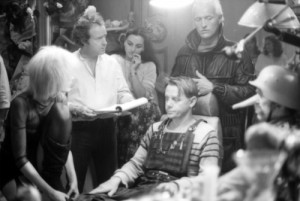
On The Set of Blade Runner with Ridley Scott, Rutger Hauer & William Sanderson
You have a long, distinguished career working with such Directors as Ridley Scott (Blade Runner), Steven Spielberg (Jurassic Park, Minority Report, The Adventures of Tin Tin) and James Cameron (Avatar). Tell me something you took away from working with these particular Directors.
Wow! First of all, I walk into work and walk away saying to myself: WOW WOW WOW!!!! To this day, I still cannot believe that I am standing on the set with these or any other Director. It is a privilege and an honor to have worked with all of the Directors I have during my career.
From Ridley, I learned so much from the very beginning, especially the care and incredible knowledge of design, pace, and creativity that he took to make that film. I did not know we were making Blade Runner, I just knew I was working on a film that was just beautiful to watch everyday. I was surprised and in total awe at the images that were being created… it was wonderful.
Then of course came Steven Spielberg. I started with him on Hook. I had just had my son, so going back to work was different this time around. I needed to work more than ever and I was hired. I couldn’t believe it. I never thought in a million years that I would work on a big production like that one. There I was, on the biggest set in MGM, back when it was stilled called MGM. It was the care that Steven took with every scene that was so marvelous to watch and be a part of. It was very hard work, a lot of detail and Steven had the whole film in his head. I had to somehow get in there. Thank goodness I got to do more films with him and after 18 years, I am just finally beginning to understand about 10%…can you believe that?
Steven is a very intense filmmaker; he works very fast and does not repeat himself. You must be prepared, prepared, prepared at all times for anything and everything, that is how he works. Because of his love and immense professionalism in his films, I have felt at all times that I must try and strive to keep up. I have learned so much about editing and staging of scenes from Steven. Just when I think I’ve got a handle on it, he surprises all of us. A friend of mine long ago said something about John Huston. He said that if you cut Huston’s veins, they would bleed celluloid. I think that of Steven Spielberg.
I did not do the whole film Avatar; I was only hired to do a couple of weeks of the live action part in Los Angeles. I accepted gladly since I wanted to see what this was all about. I was given a great surprise and a wonderful experience. James Cameron is just amazing – his knowledge, his care for every little part of the frame, his passion. It was great to be able to sit and watch him work. I loved it, especially in this new world of motion capture and 3D. It is a whole new way of making films. It was good for me to come out and learn and to adapt my work to the new wave of filmmaking.
I hope and think that overall, what I have taken from these Directors and all the others that I have worked with is an amazing love, care, passion, professionalism, and love for making films.
How did you meet Cameron and get involved with Almost Famous? Did this happen due to your existing relationship with Steven Spielberg?
Yes it did. The Producer for Almost Famous was Ian Bryce, who also produced Saving Private Ryan. When Cameron was looking for a Script Supervisor, Ian put my name on the list. I went to the interview not really knowing what would happen, but I do remember seeing him for the first time and I just liked him. Cameron is just a warm, sincere, charming and overall great person. We talked for a bit and if I remember correctly, I ended up telling him some very personal things. I think that I had the right rhythm for him. Of course, you know, with Cameron everything has to do with rhythm and images. When it’s right, it’s right. Otherwise it just does not work. I was surprised, since I am Latin and my energy is more like Charo, “cuchi-cuchi!” and all. Cameron is much more refined, but thank goodness it clicked.
Working on Almost Famous saved my life. I was in a rut in my personal life and being part of that film was just the best thing that happened to me. The story, the music, the cast, the crew, everything was full of life, laughter, joy, love and of course music… all brought together by Cameron. Loved every minute of it.
I bet continuity must have been a nightmare on Almost Famous, right?
It was a bit hard but I was prepared for it. As long as I had my breakdown down in my head and my notes ready, I was okay. I had to make sure I was ready to go everyday with the right information. I made sure to read the scenes the night before, went over all the notes from before and after and in between so that I was prepared. The rest of the crew was in the same wavelength so we were all out there being part of this wonderful movie with Cameron.
What was your biggest challenge working on Vanilla Sky?
Ah, now that is another story. That one was hard. Only because I was always wondering on the set, at home, working on the notes in my sleep: “Which one is it??? Is this the dream or is this reality?” “No, this is real.” “No, this is not.” It really was a film that was always working on you from inside, very deep, at least I thought so. But again, what a joy to work with Cameron and his love of words and music. And to work with Tom Cruise again. Those two are wonderful together – their friendship and wanting to make something good was intoxicating.
The challenge for me was to make sure that I was getting Cameron’s notes correctly, and that I could help in any way. Otherwise, it was a different experience marked with hard work, intensity, joy, and lots of music.
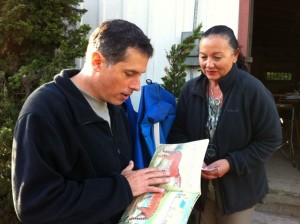
Zoo D.P. Rodrigo Prieto with Ana Maria
Was working on We Bought A Zoo as much fun as it looked?
You know, people always think that working on a film is fun, so I have to correct them by saying we are working. It is our job. It is hard work. We have to get up very early and sometimes have to work very late, even through the night. What makes a film fun for me is the project and usually when I think about it after the shooting, but not during. During the shooting I am so consumed with making sure things are right that I don’t really think about fun.
Having said that, what makes working on Cameron’s films great is that he makes you feel that you are a part of the whole project and not just doing a job. He respects and acknowledges everyone’s job on a film set. Cameron’s sets are very different,. You are all part of the process and he is incredibly accessible to everyone at all times. His care for the final product is so personal that you can’t help but be seduced. Everyday that I have worked on one of his films I have enjoyed. Hard or not, I have never once been unhappy about getting up to go to work on his set.
After four films together, tell us about your working relationship with Cameron.
I feel so proud to be able to say I have done four films with him. I am incredibly grateful for having had the opportunity to sit by his side. Warren Beatty and John Schlesinger always made me feel very proud of my job and always went out of their way to include me during the filming of their projects. Cameron has been the same for me – so giving, so open, so respectful of my craft. I admire him tremendously. He makes my job just that much more enjoyable.
Tell us something that a Script Supervisor does that people might not be aware of
We observe, we take notes, we report, we are always on, we seldom leave a set,. We sometimes play psychiatrist, mom, sister, confidante, or girlfriend. And we are the only one in our department.
Do you think that directing a feature film is still in your future?
Who knows? They say it’s never too late to start something new…who knows…it is a New Year after all, but I better hurry since the world is coming to an end…!
© 2011 – Vinyl Films/The Uncool. All rights reserved.
